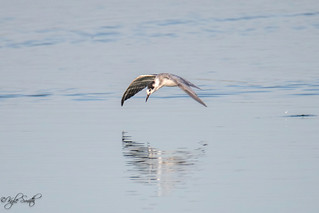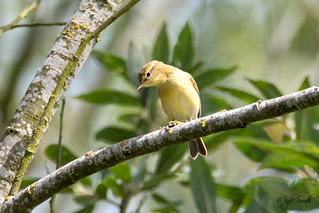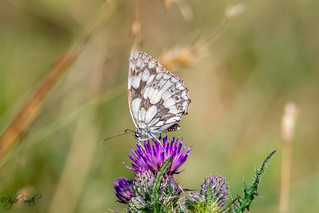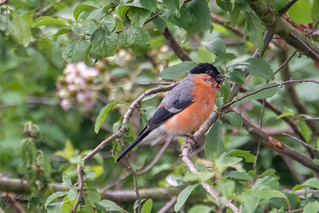A few months ago I booked a place on a nightjar walk at RSPB Arne and the day duly arrived. The weather has been unsettled but the forecast was set for 27°C, and wall-to-wall sunshine. I enjoyed the journey down in my new car (Katya), trying out the various modes of automatic drive.
I stopped at Branksome Dene Chine on the edge of Poole as this has been a consistent spot for firecrest; despite searching for half an hour I could only spot a couple of candidates high in the treetops, and no positive ID was possible. I was entertained by several common lizards basking on the side of the road as a paced up and down the slope.
I moved onto a small reserve on the other side of Poole, beside a Caravan Park - Ham Common Nature Reserve. Parking is free for half and hour but I paid the £1 fee as I hoped to stay longer. There are numbers of dartford warbler on the common here, but after a couple of circuits I couldn't find any. I ventured further into the reserve and came across three jays staying close to a row of trees. Lots of magpies circled the area and they became more active when the jays called. I haven't heard chiffchaff calling recently but there were a few in good voice here, as were some blackcaps. Good sightings of butterflies with some I didn't know - on the wing and I couldn't get photos for ID. It was getting late for lunch so I decided to move onto Arne.

As soon as I arrived I popped my RSPB card onto the dashboard (in lieu on the parking fee) and made my way to the Visitor café for a sandwich and drink. Afterwards I headed back to the car and changed into my walking boots, and loading up with a camera, scope and bins. Looking on the sightings board it appeared someone has spotted pied flycatcher in the trees leading to Coombe Heath, so I headed in that direction. Needless to say I didn't find it and no-one I asked had seen it either.

I made a circuit of the heath spotting goldcrest, coal tit, chiffchaff and juvenile male / female stonechat. On the estuary there were many shelduck and 12 curlew. As I watched, four oystercatcher flew to the far end. Small herds of sika deer grazed on the far shores. I also added little egret and black-tailed godwits.
It got later in the afternoon and I headed back to the Visitor café for a coffee, having dipped on dartford warbler. Perhaps the wind was too strong ...

I still had an hour before dinner was scheduled, so I decided to try a stroll down the Raptor trail. The only raptor I saw was a buzzard. As I reached a fence blocking the path ahead, I heard a dartford warbler gently call. I got a couple of clear views through the gorse and bracken and a few photos - many more out of focus or 'hopeful'.
With 10 minutes until dinner I reluctantly turned back.

After a dinner (chilli, then fruit salad) we went out onto the Coombe Heath again to talk about the habitat. Not even stonechats this time - I think the wind was a little stronger.
As we got to 8.45pm we headed off to a new area of heathland that the RSPB have purchased, on the other side of the road from Coombe Heath. The area was a commercial pine forest until 18 months ago. We followed a path along the lower side of the heath, bordering the woods.  The gap between was filled with bracken.
The gap between was filled with bracken.
We talked and waited for the main event. The guides were starting to look a little concerned that perhaps to wind would scupper our evening, but at 9.45pm we could hear the 'churring' of nightjars back along the track. Then a nightjar struck up right behind us, but no sighting. At about 10.00pm we eventually saw a single nightjar quarter out ahead of us and it disappeared for a minute or so before we located it on the branch of a tree ahead. No sooner than we spotted it, it alighted.

We could then hear 'churring' in several directions and saw a couple of birds on fence posts further down the track. It was effectively dark but a took a couple of photos handheld at 1/6s and ISO 12,800! A decent record and there was little chance I would be able to catch one on the wing. As we walked back we caught sight of three more. In my mind I likened their flight to terns; very slow wing beats.
We almost needed torches to navigate back to the cars and I set off for home at 10.30pm. Unfortunately the A34 was closed just passed Winchester and I had to detour through Basingstoke and Newbury, to get back onto the A34 - eventually arriving home at 1.05am. Sloped into work at 8.45am.
Sightings today (42) included: blackbird, blackcap, black-headed gull, black-tailed godwit, blue tit, buzzard, canada goose, carrion crow, chaffinch, chiffchaff, coal tit, collared dove, common tern, cormorant, curlew, dartford warbler, goldcrest, goldfinch, great spotted woodpecker, great tit, green woodpecker, greenfinch, grey heron, herring gull, jay, lesser black-backed gull, linnet, little egret, long-tailed tit, magpie, nightjar, oystercatcher, pied wagtail, raven, robin, shelduck, siskin, song thrush, stonechat, swallow, swift and woodpigeon.
 Just as we were packing our stuff back into the car, the sun started to break through - bugger. Not much you can do when the weather doesn't play nice.
Just as we were packing our stuff back into the car, the sun started to break through - bugger. Not much you can do when the weather doesn't play nice.



















































